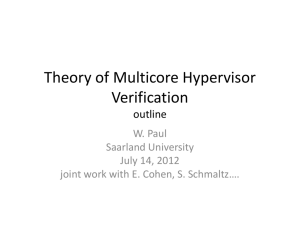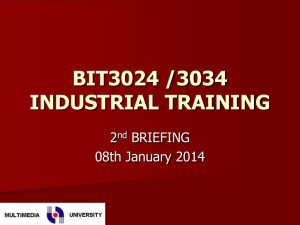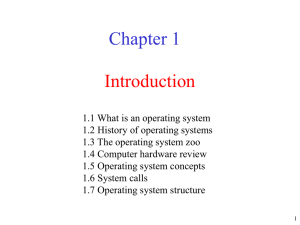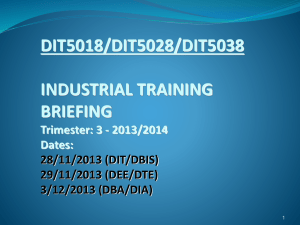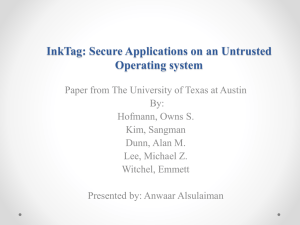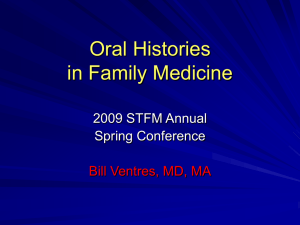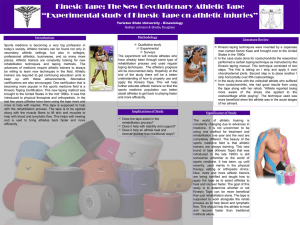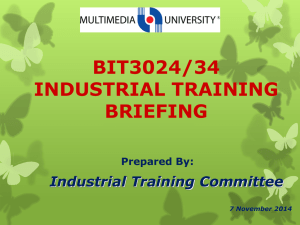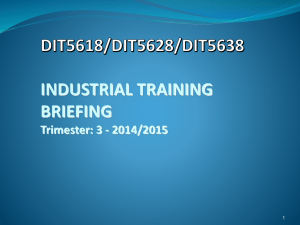Theory of Multicore Hypervisor Verification
advertisement
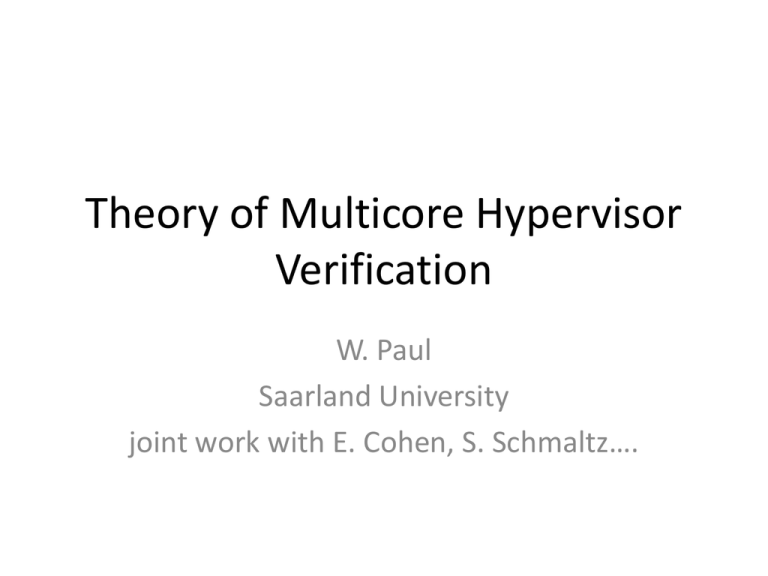
Theory of Multicore Hypervisor Verification W. Paul Saarland University joint work with E. Cohen, S. Schmaltz…. What is a kernel ? tape(1,left) s_1 tape(1,right) tape(2,left) s_2 tape(2,right) tape(3,left) s_3 tape(3,right) • The Classic: Turing machine kernel • Simulating k one tape Turing machines by 1 one tape Turing machine – Tracks: address translation – Head position and state: process control block – Round robin: scheduling What is an M-kernel ? • process virtualization: tape(1,left) s_1 tape(1,right) tape(2,left) s_2 tape(2,right) tape(3,left) s_3 tape(3,right) – simulating k machines of type M by 1 one tape machine of type M • + sytem calls – for inter process communication… • M: – MIPS, ARM, Power, x64… What is a hypervisor ? • guests can be operating systems, i.e. in system mode • 2 levels of translation – hypervisor page tables – guest page tables – ‚subdivide tracks‘ • hardware support – nested page tables • no hardware support: – composition of translations is translation – maintain ‚shadow page tables‘ (SPT) for combined translatio – redirect memory management unit (mmu) to SPTs Background • 2007-2010: effort to formally verify MS HyperV – part of German Verisoft-XT project (Paul, Broy, Podelski, Rybalchenko…), 13 Mio € – MS Windows + Research (Cohen, Moskal, Leino,…) • We failed 2010 – tool development (VCC) successful – crucial portions of code verified – tool documentation and soundness argument less than perfect – paper and pencil theory incomplete in 2010 • We did not know (exactly enough) what to prove Hypervisor Correctness is either • One theorem in 1 theory – then we are in weapons business of cycber war • or bug hunting – then we (formal verification ehineers) are competing with the software community – and may get beaten up This talk (only) 2 years after end of project • outlines – model stack for multicore hypervisor verification • I think complete – simulation theorems between layers – soundness of VCC and its use • size of remaining gaps: • <= PhD thesis • I supervised 59 so far Three kinds of arguments • abstraction – classical commutative diagrams • order construction – in nondeterministic model of concurrent implementation – from details of deterministic implementation • order reduction – exclude w.l.o.g. interleavings in concurrent model 7 main theories (1) • multicore ISA-sp – system programmers manual – hardware correctness • C+ ISA + devices – drivers – exception handlers – boot • serial ISA abstraction – to ISA-u (for users) • serial language stack – C + macro assembly + ISA-sp – compilers + macroassemblers • ownership in concurrent computation – push through stack – serial compiler translates parallel C 7 main theories (2) • Hypervisor correctness • Soundness of VCC and its use – C + ghost + assertions – VCC proofs imply ownership discipline – use of C-verifier for C+ISA + devices – virtual tread simulation (kernel layer) – nested address transation (shadow page tables) – ISA-sp virtualization ISA-sp (1) • X64 – Intel: 3000 pages – AMD 1500 pages – Diss. Degenbaev 300 pages math – http://rg-master.cs.unisb.de/publikationen/UD11.pd f • MIPS-86 – MIPS-ISA+ X86 memory model – 15 pages – http://www-wjp.cs.unisaarland.de/publikationen/Sc hmaltzMIPS.pdf ISA-sp(2): X64 disk APIC • X64 ISA model – E. Cohen: nondeterministic communicating sequential components – sb: store buffer – mmu: memory management unit – APIC: device, interrupts – disk: for booting mem + caches sb mmu • details subtle – better reverse engineer MIPS-86 and prove core ISA-sp (3): MIPS-86 hardware correctness (formal/paper) • Processor correctness – pipelined – one memory mode: WB – software conditions: alignment; no self modifying code – digital gate level + gate delays – sequentially consistent shared memory (MOESI) • April 4, 2012 – 283 pages – http://www-wjp.cs.unisaarland.de/lehre/vorlesung/ rechnerarchitektur2/ws1112/ layouts/multicorebook.pdf TODO • fetch and add (easy) •fences and sync (easy) •consistent memory modes (easy) •interrupts + devices (subtle) • MMU (subtle) • store buffers (easy) • Tomasulo scheduler (hard) ISA-sp to ISA-u (1) • Caches invisible – Use cacheable memory modes only – compatibility of coherency protocols (MOESI +….) – side remark in Smith & Plezkum mem + caches sb mmu core sb: store buffer ISA-sp to ISA-u (2) • caches invisible • sb invisible in single core – easy folklore theorem – proof: Degenbaev et al: Pervasive theory of memory 2009 – In Susanne Albers and Helmut Alt and Stefan Näher, editors, Efficient Algorithms -- Essays Dedicated to Kurt Mehlhorn on the Occasion of His 60th Birthday,Saarbrückenvolume 5760 of Lecture Notes in Computer Science, pages 7498, Springer, 2009. mem sb mmu core sb: store buffer ISA-sp to ISA-u (3) • caches invisible • sb invisible • mmu invisible – set up page table tree – linear/translated memory – easy folklore theorem – proof: Degenbaev et al: Pervasive theory of memory 2009 mem mmu core sb: store buffer ISA-sp to ISA-u (4) • • • • caches invisible sb invisible mmu invisible ISA-u mem core language stack (1) C+macro assembly + assembly+ISA-sp C compiler m-asm m-assembler ISA-u=asm before ISA-sp • C small steps semantics (interleave in parallel C) • C+ macro assembly realistic and close to VCC • uses stack abstraction • process save and restore handles stack pointers • invisible in C + macroassembly language stack (2) combined language semantics ² two languages C + A where A implement s C: ² two computations (ci ) and (ai ) ² maint ain consi s(ci ; as( i ) ) ² change of C t o A: use (ai ) but t rack e®ect on (cj ) ² change from A t o C: have ai : 1. 9c : consi s(c; a): cont inue wit h (unique) c 2. error ot herwise language stack (3) compilation • Optimizing C compiler: – Xavier Leroy. Formal verification of a realistic compiler. C ACM, 52(7):107-115, 2009. • Optimizing C Compiler + macro assembler + assembler – C calls m-asm and vice versa – function pointers – Paper theory: Diss Shadrin. http://www-wjp.cs.unisaarland.de/publikationen/ Sh12.pdf – Schmaltz and Shadrin: VSTTE 2012 – Paul et al: SEFM 2012 MIPS ISA-u +devices (1) formal hardware correctness dev 1 proc dev k – Hardware truely parallel, processor pipelined – ISA nondeterministic concurrent, 1 step at a time – construct order of steps – Diss Tverdychev, http://wwwwjp.cs.unisaarland.de/publikationen/Tv 09.pdf – hardware complex due to a detail in ISA for external interrupts that we used – ‚continue‘ instead of ‚repeat‘ as in X86 MIPS ISA-u + devices (2) formal (C+assembly)- driver correctness dev 1 proc dev k – disable and don‘t poll interrupts of devices >1 – reorder their device steps out of driver run of dev 1 – pre and post conditions for drivers… • Diss. Alkassar – http://scidok.sulb.unisaarland.de/volltexte/2009/2 420/pdf/Dissertation_1410_A lka_Eyad_2009.pdf • Alkassar et al: TACAS 08 MIPS ISA-u + devices (3) startup dev 1 proc dev k – Hypervisor: • disk: boot loader • APIC: wake up other cores • Diss Pentchev 2013? – secure boot: • digital signatures • Verisoft (2003-2007) Ownership (1) concept • Classify addresses 1. local (e.g. C stack) 2. shared and read only (e.g. program) 3. shared owned (temporarily local/locked) 4. shared writeable not owned (locks) • invariants: – at most 1 owner …. – disjointness… • safe programs: act like names of address classes suggest • accesses to class 4 atomic at the language level Ownership (2) Def: structured parallel C (folklore) • Classify addresses 1. local (e.g. C stack) 2. shared and read only (e.g. program) 3. shared owned (temporarily local/locked) 4. shared writeable not owned (locks) • multiple C threads • sequentially consistent memory • shared: heap + global variables • local: stacks • safe w.r.t. ownership – class 4 access: volatile Ownership (3) structured parallel C to parallel assembly • IF – translate threads with sequential compiler – translate volatile C access to interlocked ISA-u access • THEN – ISA program safe – multicore ISA-u simulates parallel C • A. Appel, X. Leroy et al: formal work in progress – no store buffers • Dissertation C. Baumann 2012: pushing this through entire language hierarchy on paper Ownership (4) parallel store buffer reduction in ISA-sp dirty C compiler m-asm m-assembler ISA-u=asm • maintain local dirty bits - class 4 write since last local sb- flush • class 4 read only if dirty =0 • Cohen Schirmer ITP 2010: store buffers invisible – formal – no mmu • to be pushed through hierarchy before ISA-sp – implement sb-flush as compiler intrinsic in C Ownership (5) semantics from hell hyperV dirty C compiler m-asm m-assembler ISA-u=asm before ISA-sp guest • Def: VCC-C: – structured parallel C – with Cohen Schirmer dirty bits • VCC-C + m-asm + asm +ISA-sp Ownership (5) semantics from hell hyperV dirty C compiler m-asm m-assembler ISA-u=asm before ISA-sp guest • VCC-C: – structured parallel C – with Cohen Schirmer dirty bits • VCC-C + m-asm + asm +ISA-sp – shared shadow page tables – MMU (ISA-sp) walks SPTs (volatile C data structure) – order reduction: interleave MMU steps at volatile C accesses to SPTs Model stack VCC-C +…+ISA.sp (2-5) compilation ISA-sp hardware correctness (1) digital hardware timing analysis gates+ regs.+drivers + delay (1) model and theory stack hyperV correct soundness (7) (6) – VCC is parallel C verifier VCC-C +…+ISA.sp (2-5) compilation ISA-sp hardware correctness (1) digital hardware timing analysis gates+ regs.+drivers + delay TODO • Soundness of VCC and ist use (1) • Theorem: hyperV virtualizes multiple ISAsp (+ system calls) VCC (1) soundness: arguing about ownership • C + ghost: Dissertation Schmaltz 2012 – semantics – simulation of C by C+ghost – ghost code must terminate – VCC-C + ghost • TODO for VCC soundness – Semantics of assertion language of C + ghost (logics) – show that assertions generated by VCC imply ownership + Cohen Schirmer dirty bit discipline – soundness of verification condition generator used for serial and parallel langue constructs VCC (2) use for C + m-assembly +ISA-sp • Dissertation Maus (Podelski) – hybrid C variables, located in memory outside of regular C variables – code non C portions of ISA-sp in hybrid variables – write obvious C simulator – translate m-assembly macros into C function calls in the naive way • wildly productive – 14K LOC verified • Maus et al: AMAST 2008 • soundness: – Dissertation Shadrin – Paul et al: SEFM 12 HyperV correctness (1) kernel layer: many threads • similar to kernel correctness from • Simulation of K C+masm Verisoft-1 Project (14 + ISA-sp threads by k Mio €) physical ISA-sp threads – compile C part – thread control blocks – saving and restoring stack and heap pointers – C + masm + asm – APICs hard to simulate – paper: Gargano et al: TPHOLs 2005 – formal: Alkassar et al, VSTTE 2010 • Dissertation Alekhin 2013? HyperV correctness (2) shadow page tables • 2 translations – guest-OS to user – host to guest - OS • with hardware support – nested page tables – no formal model and hardware construction yet • without harware support – composition of translations is translation – SPT for composition – Redirect MMU to SPTs • SPT-algorithm without sharing beween processors, formal – Dissertation Kovalev 2012 – Alkassar et al FMCAD 2010 • in MS product SPTs with sharing HyperV correctness(3) ISA-sp virtualization and system calls • Virtualization – with kernel layer and SPTs similar to Verisoft-1 – new: state of ISA-sp components of sleeping virtual procesors – sb empty – caches from hardware – tlb empty or tagged as in hardware • Simple Hypervisor – formal in VCC – without save/restore: Alkassar et al: VSTTE 10 – with: Paul et al: SEFM 12 • system calls and C data strutures of kernel as in formal work – seL4 (only C portion but can extend with Verisoft-1 technology) – or Diss Dörrenbächer 2010 http://www-wjp.cs.unisaarland.de/publikationen/JD 10.pdf – or Diss M. Schmidt 2011http://www-wjp.cs.unisaarland.de/publikationen/M S11.pdf (part of Verisoft automotive subproject. BroyPaul) Final remark • Paul VSTTE 2005 – a formal proof is an engineering object – a paper proof is a building plan • IFIP working group on verified software 2012 – lack of such building plans recognized as major obstcle for development of formally verified systems • very difficult to publish so far • Thank You
